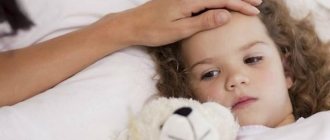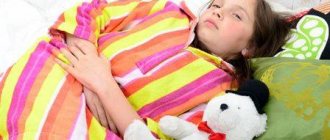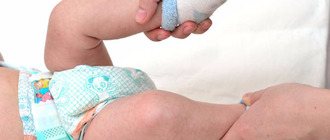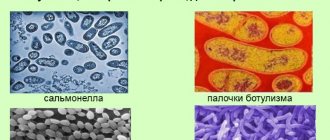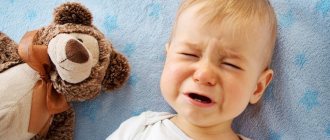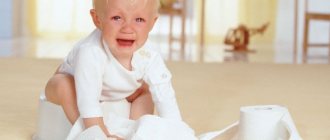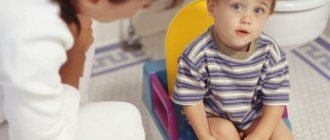Possible causes of diarrhea in children
Infection is a common cause of diarrhea in children.
Diarrhea in children can be caused by the following factors:
- Infection of viral or bacterial origin.
- Food intolerance.
- Drinking a lot of juices.
- Poisoning.
- Food allergies.
- Ear infection.
- The presence of parasites in the body.
- Use of antibiotics.
The appearance of the pathology in question requires medical attention. The factor that provoked the development of diarrhea should be determined by the pediatrician. This will help avoid negative consequences.
Causes
If diarrhea begins in a child whose age is 1 year (or more), then the causes of the malaise, which occurs without fever, can be various factors, both completely harmless and serious:
- Poor nutrition - violation of the usual diet, consumption of spoiled food or raw water. In such cases, fever can appear at any time due to exposure to toxic substances.
- Infectious diseases . Weakness, loss of appetite, tearfulness, nervousness, disturbances in the general condition of the child, painful nausea, and vomiting can occur when bacteria or viruses enter the body. In this case, the child develops diarrhea and stomach pain; such pathologies rarely occur without fever. Mostly in the early stages.
- Dysbacteriosis . The development of dysbiosis often begins with antibiotic therapy. If proper treatment is not carried out, then after 5 days the diarrhea will become chronic and will occur both with and without an increase in temperature.
- Enzyme deficiency . There are no sensations of abdominal pain or fever, although diarrhea can last for quite a long time: days/weeks/months.
- Allergy . Allergic food reactions may be accompanied by frequent diarrhea and vomiting. Undigested pieces of the product to which the baby’s body reacted negatively are found in the stool and vomit.
In order to correctly determine treatment tactics, it is necessary to identify the cause of the disorder. There are significant differences in the diagnosis and treatment of these pathologies, so medical advice cannot be avoided.
Power supply errors
The most common causes of diarrhea in children of any age are:
- Binge eating. Provokes loose stools in a 1-2 year old child without fever. At the same time, the baby becomes lethargic and capricious. He may feel nauseous.
- Inappropriate choice of complementary foods. The child develops diarrhea without fever due to a deficiency of certain enzymes due to the immaturity of the intestinal environment.
- Eating large quantities of natural vegetables and fruits, sweets, and fatty foods. This can cause diarrhea and upset digestion.
Diarrhea in a one-year-old child without an increase in temperature can become chronic, causing dehydration and the development of pathologies in the gastrointestinal tract. Parents should be as careful as possible about the baby’s menu, diet, and quality of products.
Infectious diseases
If a child experiences abdominal pain with diarrhea, but the body temperature remains normal, this does not exclude the possibility of infection with viruses and bacteria. Already on the second or third day, diarrhea may be accompanied by a significant increase in temperature and a sharp deterioration in the patient’s well-being. The disorder can be caused by:
- Gastroenteritis, colitis, enterocolitis, which is a disease of dirty hands. These ailments often provoke bloody diarrhea in a child without fever.
- Salmonellosis and shigellosis in the initial stages.
- Viral and bacterial diseases, for example, pneumonia, sore throat, influenza.
Intestinal infections are most common among children attending preschool institutions. Therefore, it is especially important to teach them the rules of personal hygiene from a very early age.
Intestinal dysbiosis
Most common in young children. In this case, the normal ratio of beneficial and harmful microorganisms in the intestinal environment is disrupted.
This condition can be caused by:
- Artificial feeding.
- Poor food.
- Treatment of infection with antibiotics.
- Frequent constipation and diarrhea. Chronic diarrhea indicates disorders occurring in the gastrointestinal tract. In such cases, diarrhea lasts a week or longer.
- Allergies (food, medication).
- Exposure to radiation.
- Damage to helminthic infestations.
- Intestinal infections.
Enzyme deficiency
Based on its origin, this pathology is divided into congenital and acquired. In the first case, enzyme deficiency is associated with gene defects and disruption of the pancreas.
Acquired enzyme deficiency is observed in children who are faced with:
- Infectious diseases.
- Protracted illnesses of any origin.
- Drug poisoning.
- Dysbacteriosis.
- Exhaustion due to malnutrition of the child.
- Living in an unfavorable environmental environment.
Other pathologies of non-infectious origin
Only a doctor, having ruled out the infectious factor, will be able to find the true cause of the little patient’s ailment. Diarrhea in a 2-3 year old child without an increase in temperature can be caused by:
- Worm infestations.
- Surgical pathologies of the gastrointestinal tract.
- Allergies.
- Stress.
- Overheating.
- Cystic fibrosis.
If a child has diarrhea, vomiting, nausea without fever, this may be due to a head injury.
What to do if a child has diarrhea?
Below are steps to relieve diarrhea in children of different age categories.
Newborn baby
If your newborn has diarrhea, you should consult a doctor.
If diarrhea occurs in a baby, you should definitely call a pediatrician at home. Before the doctor arrives, you should wash your baby after each bowel movement, but it is not recommended to use wet wipes as a means of hygiene, since their frequent use can provoke irritation and allergic reactions.
It is also necessary to monitor the general condition of the baby. In case of lethargy, drowsiness, or prolonged absence of urination, you should give warm water to avoid dehydration.
The mother needs to adjust her diet (provided she is breastfeeding). Among medicines, preference should be given to Hillak and Smecta, which can be used from birth.
Any other medications should be abandoned; appropriate treatment should be prescribed by a pediatrician; self-medication can lead to serious consequences. Traditional methods of eliminating diarrhea are not suitable for recently born children.
Give smecta in small portions every third of an hour. Hillak medicine is taken before meals, 15 drops. You should also collect feces in a jar for analysis, since the pediatrician will be able to make a preliminary diagnosis based on their consistency and color.
If diarrhea develops, be sure to monitor the child’s weight. You should not limit your baby’s food intake, but the amount of milk consumed should be reduced.
One year old child
A one-year-old baby with diarrhea can be given sorbents, for example Polysorb
If a child develops diarrhea at the age of one year, you should:
- Assess the nature of bowel movements.
- Conduct an analysis of possible factors that could provoke the development of pathology (for example, new food, stress).
- Measure body temperature.
- Monitor your drinking regime (to prevent dehydration).
- Give the baby enterosorbent medications (Smecta, Polysorb or Activated Carbon).
You can also use Regidron or Glucosan to prevent the development of dehydration, since during diarrhea the body loses a large amount of fluid. Give the medicine to the baby a couple of tablespoons every ten minutes. If the child does not want to take the medicine, you can replace it with unsweetened tea or cooled boiled water.
If diarrhea is accompanied by other symptoms, seek medical attention.
3 years
Phosphalugel will help your child cleanse the intestines of germs
With the pathology in question, at three years old the child’s drinking regime should be taken under control. It is also permissible to use medications (Regidron, Di-sol) or a home remedy, which can be made as follows: pour into boiling water. water (1 l), a teaspoon of table salt and 6 tsp. granulated sugar. Give the medicine to the child in small portions.
You should also give your baby medications to cleanse the intestines of pathogenic microorganisms (Phosphalugel, Activated Carbon, Smecta, white clay, Polysorb).
If diarrhea develops, you should not feed the baby rough and heavy food, as it will not be digested and will only increase diarrhea and pain in the abdominal area. It is also strictly not recommended to use antibiotics and other medications without a doctor’s prescription.
6 years
Smecta will stop diarrhea in a child
If diarrhea occurs at 6 years of age, fluid intake should be monitored. Parents need to measure the baby's body temperature. It is advisable to use Rehydron or Glucosolan to normalize the water-salt balance.
It is recommended to use Smecta or Polysorb. Any other medications should not be given to a child without consulting a pediatrician.
Traditional methods of treating diarrhea help well:
- A decoction of fennel, sage, and oak bark.
Combine 1 tbsp. water with a tablespoon of raw materials. Boil for ¼ hour, then strain and cool. Give the child the resulting healing liquid three times a day. a day, half a glass per dose.
- A decoction of dried bird cherry and blueberry berries (in a ratio of 3:2).
Mix a spoonful of the dry ingredient with a glass of water, boil for about a third of an hour. Drink ¼ tbsp. three times/day.
During diarrhea, it is necessary to adhere to dietary nutrition.
What to do if your baby is vomiting and has a high fever?
Diarrhea with vomiting and fever
A sharp rise in temperature indicates the infectious nature of the disease. Pathogenic bacteria multiply in the intestines of a sick child. With diarrhea, the body tries to get rid of toxins.
If a child eats low-quality food, he or she may become poisoned. Vomiting should not be considered as a separate disease. It performs a protective function that helps the body get rid of harmful components.
Watery diarrhea in a child occurs after harmful bacteria enter the intestines. Frequent urges lead to rapid depletion of the child’s vitality. The baby is suffering from dehydration. A baby with such symptoms should be taken to the hospital as quickly as possible.
How to treat diarrhea that is accompanied by other symptoms?
Below are methods to eliminate diarrhea accompanied by various symptoms.
Vomiting
In case of diarrhea accompanied by vomiting, it is necessary to call for medical help; before it arrives, the child should be placed on a bed with a pillow under the head, and the newborn should be kept upright.
After each episode of vomiting, it is recommended to rinse the child’s mouth to eliminate the unpleasant taste and residual liquid, and ensure that the baby drinks plenty of fluids. Cooled boiled water should be alternated with saline solution. The child should be given a small amount of liquid at a time (a couple of sips) every 15 minutes.
If the temperature increases, use antipyretic medicine. It would not be superfluous to use Smecta or Polysorb, as well as means to maintain water-salt balance.
To prepare such a medicine yourself, you will need 1 liter of cooled boiled water, a teaspoon of table salt, 4 tsp. granulated sugar. Mix all ingredients and give to baby after each episode of vomiting or bowel movement. This medicine can be stored for no more than a day.
If the condition improves, you can give the baby a small amount of banana, homemade white bread crackers, apple puree, rice porridge or broth. Infants' meals should remain as usual, but the amount of milk consumed at one time should be reduced.
Treatment of vomiting and diarrhea in infants up to 12 months. carried out in a hospital, regardless of the reason that provoked their appearance.
Temperature
If a high temperature occurs, an antipyretic should be given.
In case of diarrhea accompanied by increased body temperature, it is strictly forbidden to give the child antibiotics and other medications without medical prescription. The exceptions are enterosorbents and antipyretics.
If such an unpleasant phenomenon occurs, you should call a doctor, and before he arrives, monitor the child’s drinking regime; it is recommended to use Regidron.
You can make such a product yourself. To do this, mix 1 tbsp. l. sugar, 1 tsp. table salt, half a tsp. baking soda with a liter of boiling water. water.
Of the products that have a fixing effect: jelly, porridge or rice broth, carrots, and a decoction of pomegranate peel have a fixing effect.
Water diarrhea
Rice water can help stop diarrhea in a child
If watery diarrhea occurs in a child, first of all, it is necessary to prevent dehydration. You should limit your baby’s food intake and control his drinking regime.
Diarrhea with colorless or white stools may indicate the development of cholera. In this case, you need to immediately call an ambulance or take the child to the doctor yourself.
It is quite difficult to bring the water-alkaline balance of a child’s body back to normal on your own. In this case, intravenous administration of drugs will be required.
With the help of medications such as Smecta, activated carbon, Enterosgel, Atoxil, the child’s condition can be alleviated. However, it is worth considering the age of the baby, since not all drugs are suitable for the early younger age category. The use of probiotics will help normalize the intestinal microflora.
If the child's body temperature has increased, you can give a drug containing paracetamol. No-spa (one-third of a tablet) will help with abdominal cramps.
Also, therapy to eliminate watery diarrhea can be carried out using folk remedies:
- Rice water, which has an astringent and enveloping effect.
To prepare it you will need a glass of water and a teaspoon of rice. Cook on low heat for 40 minutes. Drink 50 ml 3 times a day.
- Compote of dried blueberries or pears, which will nourish the child’s body with useful compounds.
- Starch solution (1 tsp per ½ cup of water).
If the condition worsens and additional symptoms occur in the form of increased body temperature, vomiting, pain in the abdomen, you should seek medical help.
Diarrhea with mucus
Such a phenomenon should be a signal to call the pediatrician; before he arrives, you need to frequently give the baby water to prevent dehydration. However, food should be limited. If the child is hungry, it is allowed to eat crackers made from wheat bread, crackers, and hard cookies.
You cannot give medications to your child on your own. Diarrhea with mucus, especially if it has a greenish tint or blood, may indicate the development of a serious illness, the treatment of which requires specific therapy. The use of medications can negatively affect the correct diagnosis.
Diarrhea with blood
In case of such a pathology, it is necessary to call an ambulance, since such a phenomenon can signal serious disorders in the body. Before medical help arrives, you should collect the contents of the stool in a jar.
The baby should not be given food, with the exception of boiled carrot puree, to which a little boiled water has been added.
Every five minutes, drink warm water (20 ml per dose), which can be combined or replaced with Regidron or Orolite. To make the medicine yourself, you need to add a couple of large spoons of sugar, 1 teaspoon each of salt and soda in 1 liter of water. Give the baby a couple of teaspoons every 10-15 minutes.
In case of increased temperature, it is worth giving the child a drug containing paracetamol. To cleanse the body of pathogenic microorganisms, you can use medications in the form of Polyphepan, Enterosgel, Polysorb, Smecta.
After each bowel movement, you need to wash the baby, and it is also recommended to apply a little baby cream to the anus to prevent the development of irritation. Do not use wet wipes as a hygiene product during frequent bowel movements.
How can you treat diarrhea?
Diarrhea in a child is not always a sign of infection or poisoning. If there is no fever, the baby is active, there are no suspicious inclusions in the stool, treatment can be done at home.
You cannot do without professional help if:
- the temperature rose sharply;
- vomiting began;
- the child is very weak;
- there is blood and foam in the stool;
- the stool has acquired an atypical color;
- diarrhea does not stop for more than a day.
Children under one year old deserve special attention. Due to their low weight, they lose fluid very quickly, and dehydration develops very quickly.
If such signs occur, you must contact the infectious diseases department. After examining the child and examining the stool, treatment is prescribed. If a bacteriological or viral nature of diarrhea is suspected, a laboratory examination of stool is performed.
Treatment in a hospital lasts several days and depends on the age, condition of the child and the type of infection.
First aid: what to do to stop diarrhea?
Alimentary diarrhea can be stopped at home. To do this, it is enough to exclude the irritating factor - any food. Loose stools usually disappear after a few hours.
It happens that, against the background of the disorder, the appetite remains at the same level and the child asks to eat. You can offer him a cracker or unleavened cookies with weakly brewed tea.
It is strictly forbidden to feed the child:
- fermented milk products;
- fresh fruits, vegetables and juice from them;
- solid food.
If diarrhea is accompanied by vomiting, the amount of liquid should not exceed 20 ml, but you need to drink every 10-15 minutes.
Infants do not stop breastfeeding. It must be remembered that mother’s milk will not be able to replace the fluid lost by the body, so between feedings you need to pour 5 ml of water into the baby’s mouth.
While waiting for an ambulance, you can give an absorbent agent (Smecta or Activated Carbon). These drugs are not absorbed into the blood, so they are harmless even for babies.
Medicines and preparations for children with diarrhea
Drug therapy for diarrhea in children consists of several areas:
- Restoration of water-salt balance.
For this, use Regidron or Glucosalan. The drug in powder form is diluted in warm water and given in small sips after 5-10 minutes.
Absorbent preparations will cope with this task: Activated carbon (in powder, tablets or gel form), Smecta, Enterosgel. These products absorb not only toxins, but also molecules of other medications, so you need to maintain an interval of 1.5-2 hours between different drugs.
- Levomecitin, Enturol, Furozalidone are used for antibacterial effects.
- Restoration of microflora is carried out with the help of probiotics and prebiotics: Linex, Enterol, Bifiform Baby.
- Normalization of peristalsis.
For diarrhea accompanied by uncontrolled contractions of the intestines, Loperamide or Imodium is prescribed.
If diarrhea is caused by waste products of helminths in combination with symptomatic treatment, antihelminthic drugs (Nemozol, Pirontel) are prescribed.
The type, form and dosage of medications for diarrhea in children is determined by the pediatrician. It is strictly forbidden to use medications intended for adults.
Traditional medicine at home
In addition to basic treatment, you can use proven recipes from unofficial medicine:
Rice decoction for stool consolidation
2 tablespoons of cereal are washed once and poured into hot water (about half a liter).
Cook over low heat for 35-45 minutes. The cooled broth is ground until smooth and given to the child 1-2 tablespoons several times an hour.
Bird cherry decoction
A handful of dry berries is poured with 2 cups of boiling water and simmered in a water bath for half an hour. After cooling, the liquid is filtered and given to the child 20 ml after 2 hours. For children under 3 years old, a teaspoon is enough.
Oak bark decoction
It solves several problems at once: it makes stool denser, eliminates the process of inflammation in the mucous membrane and destroys some microbes. It’s easy to prepare: oak bark is poured with boiling water in a ratio of 1:2 and heated in a water bath for 20 minutes. The cooled liquid should be drunk 50 ml 4-5 times a day.
Rosehip decoction
Contains many vitamins, it is recommended to drink it instead of tea if there are signs of dehydration. It is very simple to prepare the product: pour a handful of rose hips with a liter of water and boil for 7-10 minutes. The container with the decoction is left to infuse for an hour under a warm blanket.
Chamomile tea
Has anti-inflammatory and analgesic agents. Taking it during diarrhea soothes the inflamed mucous membrane and eliminates discomfort. The plant can be added to regular tea or brewed separately (1 tablespoon per glass of boiling water).
Despite being completely natural, the listed remedies may have undesirable effects, so be sure to consult your doctor before using chamomile.
Nutrition and diet during treatment
Starting from the second day, you can introduce porridge with water (oatmeal or rice), ground dietary meat, vegetable broths, low-fat cottage cheese, hard-boiled eggs, and omelet into your diet. All food must be prepared without adding spices.
For normal diarrhea, such a diet is followed for no more than a week; if diarrhea is caused by an infection, it is continued until complete recovery.
To prevent diarrhea in children, you must strictly follow the rules of hygiene, heat-treat meat and fish dishes, and wash vegetables and fruits with soap.
In most cases, watery diarrhea in a child occurs as a result of an infection entering the child's stomach.
This phenomenon is often accompanied by fever, nausea and headache. What to do in such cases and how to alleviate the child’s condition? Let's figure it out.
Traditional methods of treating diarrhea in children
An infusion of walnut leaves is an effective remedy for diarrhea.
Therapy with traditional medicines is quite effective and safe. Recipes for preparing traditional antidiarrheal medicines:
- Decoction of pomegranate peel.
1 tbsp. l. raw materials, pour 200 ml of boiling water, cover with gauze, put in a dark place for several hours. If you use a thermos, the healing liquid will be ready in 1 hour. Consume in small portions 3–4 times a day for no more than 2–3 days.
It is worth considering that this product is not suitable for infants.
- Infusion of walnut leaves.
Pour a glass of hot water over the leaf and leave for about 10 minutes. Take several sips at a time.
- Decoction of oak bark.
Place a spoonful of raw materials in a saucepan with 250 ml of water, boil the liquid, and leave to steep for 60 minutes. After time, strain. Give the child small amounts of water every 1 to 2 hours.
You can also use chamomile tea, chicory, a weak solution of potassium permanganate, bananas, applesauce, cereals and rice decoctions to relieve diarrhea.
You can learn more about how to stop diarrhea in a child from the video.
Diarrhea is an unpleasant and life-threatening condition. And, in general, sad! The stomach aches and sometimes hurts, the mood is at zero, delicious food causes an attack of melancholy, and the toilet becomes your best friend. It's good if this is a one-time occurrence! And if the process does not stop, intensifies, blood inclusions appear or, conversely, water flows, then you need to pull yourself together and consult a doctor.
Diarrhea - some information about your own bowel movements
Diarrhea is a pathological condition of the body
Normally, an adult excretes from 100 to 300 g of feces per day. It all depends on the amount of food consumed and the coarse dietary fiber in it. The frequency of bowel movements is an individual matter, but if you go to the toilet more than 3 times a day, then you have diarrhea.
If the gastrointestinal tract system operates normally, then the amount of liquid in the stool is about 60%. And nothing bothers the person. If the balance is disturbed - the liquid in the feces reaches 90% - diarrhea begins. Even diarrhea in medical practice is subject to classification. Therefore, diarrhea can be of the following types:
- Secretory – so-called “water diarrhea”
- Osmolar - frequent and copious stools with pieces of undigested food
- Hyperkinetic – disturbance of intestinal motility
- Hypokinetic – decreased intestinal motility
- Exudative - disorders of the intestinal lining due to the inflammatory process - ulcers, dysentery, and so on. The stools are purulent and mixed with blood.
Diarrhea with water. Secretory diarrhea in more detail
The mechanism of development of this type of gastrointestinal disorder is as follows:
- Increased movement of electrolytes into the intestinal lumen
- Electrolytes pull water with them, and watery diarrhea begins
Reasons for the development of pathology:
- Infection – foodborne illnesses, cholera, staphylococcus, some strains of E. coli, bacteria of the species Yersinia enterocolitica
- Damage from toxic substances - arsenic, phosphorus compounds, insecticides
- Genetic diseases - folic acid malabsorption
- Some cancers - pancreatic tumors, gastrinoma, medullary thyroid cancer
- Taking certain laxatives - castor oil, buckthorn bark, rhubarb
With this type of diarrhea, all pathological processes are concentrated in the small intestine.
Diarrhea with water. Main symptoms
Watery stool is common in children
When visiting a doctor, it is important to be honest about your symptoms. The process and result of treatment depends on this. Typical signs of secretory diarrhea:
- Liquid, partial, watery bowel movements – from 5 to 10 liters per day
- No noticeable stench
- Almost complete absence of signs of intoxication
- Pain syndrome is not observed or is mild
- The temperature rises slightly - to a maximum of 37.8 °C
- No false urge to defecate
- Fasting does not help stop diarrhea
- There are high levels of sodium chloride in the stool - the composition is similar to blood plasma
- There are no leukocytes or blood clots in the stool
- Low levels of potassium ions in the blood - because of this, the patient may experience seizures
Prevention
If a child has a frequent urge to defecate, if defecation occurs with liquid feces, you need to adhere to a diet and follow the rules of hygiene.
- A baby should not stop feeding breast milk. You need to apply it to your breast more often.
- Add 2-3 teaspoons of Regidron to artificial feeding.
- Older children should include more slimy porridges in their diet: oatmeal, rice.
- Offer low-fat broths with meat so as not to burden the stomach and intestines.
- The menu includes baked apples, bananas, and persimmons.
- It is possible to include a diet of eggs: 1 pc. per day.
- As a sweet treat, offer your child biscuits or crackers.
Diarrhea in childhood is very common, especially in preschool age. Digestive disorders can be caused by dietary errors, infections or diseases of the internal organs. To effectively treat diarrhea in children, it is important to correctly determine the cause.
Diarrhea with water. What happens during a doctor's examination
The outcome of treatment for secretory diarrhea depends on the correct diagnosis. Diagnostics is as follows:
- Questioning the patient - the presence and nature of complaints, duration of diarrhea
- Examination of the patient - special attention should be paid to the degree of dehydration and symptoms of hypokalemia - convulsions, muscle roll syndrome
- Proctological examination - this will reveal tumor processes, fissures or fistulas of the anus
- Study of stool tests - coprogram, parasite eggs, stool occult blood test, bacterial culture
After the research and diagnosis, the doctor decides whether to hospitalize the patient. With secretory diarrhea, no signs of severe intestinal infection, or mild dehydration, adult patients can be treated at home. In all other cases, including pregnant women, treatment in a hospital setting is indicated.
Diagnosis of diarrhea in children is difficult. It is necessary to take into account the age characteristics of the child. Treatment is only inpatient, since dehydration and prolonged diarrhea for a baby can be fatal.
Treatment
There are two main ways to combat watery diarrhea in children - medications and herbal preparations. The first is the main measure to prevent loose stools and accompanying painful symptoms. After diagnosis, the doctor prescribes a treatment regimen and certain medications to combat the disease. They need to be used for a limited amount of time, no more than 10-14 days, so as not to provoke addiction in the child or an allergic reaction.
The most commonly used drugs for the treatment of water diarrhea in a child include Linex, Smecta, Loperamide, Imodium. They normalize the intestinal microflora and have a mild strengthening effect.
Medicines to treat diarrhea
| Drug name | Features of the action | Contraindications |
| Linex | is a probiotic, helps restore normal intestinal microflora, normalizes its functioning, stopping diarrhea | fungal infections in the intestines, allergic reactions |
| Smecta | adsorbs and removes viruses and other pathogens, relieves inflammation, removes loose stools | constipation, allergic reactions |
| Loperamide | affects the nerve endings in the intestines, changes metabolism, relaxes the intestinal muscles, relieves pain, removes diarrhea | should not be given to babies under one year old |
| Imodium | affects nerve endings in the intestines, changes metabolism, reduces pain, removes diarrhea | should not be given to babies under one year old |
Cleansing medications include Polysorb, Enterosgel, and activated carbon. They bind and remove toxins and pathogens from the baby’s digestive tract. Sorbents also help in case of endogenous toxicosis.
The main contraindications for these drugs are serious diseases of the digestive tract in children and a tendency to constipation. You should also not take the above sorbents if you have an individual intolerance.
Herbal remedies
The most common natural remedies for combating watery diarrhea in children include concentrated rice broth, infusion of St. John's wort, chamomile, and black tea. Traditional methods for the treatment of intestinal disorders are auxiliary therapy. They cannot eliminate serious intestinal problems such as cholera, dysentery, and exacerbation of chronic diseases.
Proper nutrition
Children must follow a diet during treatment and during the recovery period. Completely exclude fried, salty, and smoked foods from the child’s diet. It should include the following products:
- warm compotes of blueberries, cranberries, dried fruits, sweet herbal tea, mineral water;
- kefir, yogurt, fermented baked milk, cottage cheese,
- sticky whole grain porridge
- lean beef, crackers.
When feeding during the recovery period, follow the principle from simple to complex, monitoring the baby’s condition. Often, due to poor nutrition, a child experiences problems with the digestive system.
Diarrhea with water. Treatment tactics
Diet and even fasting as a treatment for diarrhea
The choice of treatment depends on the causes of the disease:
- Diet is a prerequisite for recovery
- Detoxification measures - if the cause of diarrhea is due to the effects of medications or toxic drugs
- Antibiotics – if the disease is caused by bacteria
- Rehydration - replenishing fluid loss
- Drugs to restore normal intestinal motility
If, during examination, tumor neoplasms are revealed, the patient is referred to a doctor of an advising profile - an endocrinologist, oncologist-gastroenterologist. In this case, without treating the underlying disease, secretory diarrhea cannot be stopped. All medications are prescribed by the attending physician and selected individually.
The length of use of antibacterial agents depends on the severity of the disease and can last up to 2 months.
Diet and rehydration for secretory diarrhea
Why is this type of diarrhea dangerous? This is a loss of fluid and microelements! Therefore, during treatment you will have to drink liters. Most often, just plain water is enough, but if electrolytes are lost, the doctor may prescribe special rehydration medications such as Regidron. For mild to moderate severity of the disease, the liquid is taken orally. Only 15% of cases require intravenous infusions. Indications for infusion are severe dehydration and childhood of the patient. Diet for secretory diarrhea:
- Small meals up to 5 times a day
- Dishes are steamed, baked or boiled. Preferably pureed
- Everything spicy, fried, salted, smoked is prohibited
- Food temperature – average 30–35 degrees
What can you eat if you have watery diarrhea:
- White breads in the form of croutons - no raisins or seasonings
- Vegetable soups, first courses in low-fat broth
- Boiled porridge - any - buckwheat, oatmeal, rice in water or diluted milk
- Stewed or baked vegetables without peel, boiled or baked potatoes in their jackets
- Boiled eggs or better as an omelet
- Green tea, compotes, fruit drinks without sugar, still mineral water.
Strong coffee and alcoholic drinks are completely prohibited until recovery
This is the recommended menu; all the subtleties and nuances of nutrition for secretory diarrhea are best discussed with your doctor.
Secretory diarrhea. Consequences
Preparations for restoring intestinal microflora
One should not naively believe that such a violation of the mechanism of absorption and excretion of fluid and feces for the body will pass painlessly. If left untreated, the following unpleasant symptoms may develop:
- Dehydration due to massive fluid loss and impaired water metabolism
- Imbalance of electrolytes, trace elements and vitamins
- Hypokalemia – massive loss of potassium in feces
- Acidosis - disturbances in the acid-base balance, decreased pH of the body
- Hyponaremia – removal of sodium from the body due to fluid loss
- Maladsorption – loss of nutrients due to rapid transit through the stomach and intestines
Diarrhea itself is a pathological condition for the body. The consequences of an untreated disease can be worse than the underlying illness. Therefore, do not dismiss seemingly trivial diarrhea with water. This could be a sign of serious health problems. Don't self-medicate! If diarrhea lasts more than a day, you should consult a doctor. This is especially true for pregnant women and children.
What is traveler's diarrhea? The video will tell:
Water diarrhea in children is quite common due to disturbances in the gastrointestinal tract.
Diarrhea is the body’s reaction to an irritant that has entered it. In this case, the stool acquires a liquid consistency, often watery.
So what are the causes of watery diarrhea and how to treat it?
Reasons for appearance
Watery stools appear in a child under the influence of various factors. It often happens that one is superimposed on the other, and loose stools are a combination of several factors. It is imperative to determine what caused it in order to prescribe the correct treatment and avoid water diarrhea in the child in the future.
Causes of watery diarrhea in children
The causes of diarrhea in children can be completely different: from food poisoning to intestinal infections.
The most dangerous thing about this condition is the risk of dehydration; for children this is fraught with serious consequences.
Before highlighting the main causes of the unpleasant symptom, it should be noted that the appearance of watery diarrhea is most often caused by damage to the small intestine.
This type of diarrhea often occurs in the summer. And the appearance of diarrhea with water in the cold season may indicate an infectious infection.
Moreover, regardless of the cause of diarrhea in children, the body loses invaluable fluid. It is necessary to control the baby's drinking regime, no matter what treatment is prescribed.
The disease can not only be infectious in nature, but also be caused by problems with the digestive system.
There are a number of possible causes of water diarrhea:
- infection with intestinal infection;
- uncontrolled use of antibiotics;
- Malabsorption syndrome;
- allergic reactions;
- diseases of the gastrointestinal tract;
- helminthic infestations;
- enzyme deficiency;
- nervous overexcitation;
- individual intolerance to certain products;
- acetonemic syndrome;
- teething in infants.
In the vast majority of cases, the cause of watery stools is intestinal infections.
The disease is accompanied by other symptoms, such as fever up to 39 degrees, nausea and vomiting, lack of appetite and others.
Diarrhea is the body’s protective reaction to an intestinal infection that has penetrated inside (rotavirus, enterovirus).
In this way, we get rid of not only pathogens, but also their waste products, that is, toxins.
In the case of taking antibiotics, water diarrhea occurs due to the death of beneficial intestinal microorganisms. This disrupts the absorption of water and nutrients.
Malabsorption syndrome is a chronic disease of the digestive system, characterized by a problem with the absorption of nutrients in the small intestine.
In addition to diarrhea, there are other symptoms: abdominal pain, weight loss, electrolyte imbalance, anemia, hypovitaminosis.
If a child experiences diarrhea without fever, it is most likely due to food poisoning, overeating, indigestion, or stress.
There are cases when watery diarrhea may indicate diseases of the gastrointestinal tract or endocrine system.
If you suspect the presence of such, then the baby must be urgently taken to a specialist.
Video:
The causes of water diarrhea may be food intolerance or allergic reactions.
For example, when introducing new foods into the diet, such a problem may arise.
Severe water diarrhea in children can be a symptom of illness, so parents should immediately contact a specialist if:
- watery diarrhea occurs more than 4 times a day;
- the baby's stool contains blood;
- body temperature rises to more than 39 degrees;
- noticeable weight loss began.
These symptoms indicate a possible inflammatory process in the gastrointestinal tract. The child requires urgent examination by a doctor to prescribe treatment.
Classification of diarrhea in children
There are several types of diarrhea in children:
Digestive disorder caused by the penetration of viruses and bacteria into the child’s body (dysentery, intestinal flu, salmonellosis).
Diarrhea caused by poisoning with chemicals: mercury, arsenic, household chemicals.
Digestive disorders are associated with dietary habits and may be caused by intolerance to some product.
Diarrhea is a symptom of enzyme deficiency in pathologies of the pancreas, small intestine or liver.
Diarrhea develops after long-term use of medications (usually antibiotics) due to disruption of the intestinal microflora.
Diarrhea occurs after experiencing fear or stress due to a violation of the nervous regulation of intestinal motility.
Any type of diarrhea can be acute - it occurs suddenly, the symptoms develop rapidly.
Chronic diarrhea occurs due to intestinal irritation; loose stools do not stop for several weeks. The disorder may be caused by diseases of the digestive system or lactose intolerance.
Diarrhea with water - treatment
How to treat watery diarrhea in children? To treat diarrhea in a child, you can use both traditional drug therapy and treatment with proven folk methods.
The main thing is to soberly assess the child’s condition and not take matters to extremes. If the child’s condition worsens, it is better to call an ambulance or a doctor at home.
It is recommended to limit the child's food intake and increase the drinking load. The main task of parents when a child has diarrhea is to prevent dehydration of the child’s body.
Accordingly, for this you need to offer the child to drink water, tea, compote, herbal decoctions, specialized pharmaceutical powders to restore the water-salt balance in the body.
You can prepare such a solution at home. To do this, in one liter of boiled water you need to dissolve one teaspoon of salt, half a teaspoon of soda and 2-3 teaspoons of sugar.
It is important to know that clear or white watery diarrhea is the first sign of cholera. If the child's stool looks like odorless rice water, then urgently take the child to a medical facility.
At home, it is almost impossible to normalize the water-alkaline balance in a child’s body. In this case, intravenous administration of drugs is required.
Treatment for watery diarrhea should be started as early as possible, since fluid loss can be extremely dangerous for a baby.
You can alleviate the child's condition with the help of enterosorbents. For example, Smecta is a remedy for diarrhea of natural origin; it contains clay, which is rich in microelements (silicon, calcium, magnesium).
The drug absorbs toxic substances and excess fluid, thanks to which watery stools gradually stop.
Smecta is often prescribed for the treatment of rotavirus infection in children, but the drug can also be useful for the treatment of diarrhea caused by other causes.
In addition to Smecta, you can give your child Enterosgel, activated carbon, Atoxil.
Probiotics will help restore the children's intestinal microflora. When taking antibiotics, children must also take probiotics - Linex, Enterol, which populate the gastrointestinal tract with beneficial microorganisms.
Enterol is effective in treating diarrhea that is caused by bacteria, viruses, fungi and even some parasites.
At the same time, it does not disrupt the intestinal microflora, but only eliminates diarrhea. Linex is approved for use by children, has a wide spectrum of action, does not disturb the intestinal microflora, and gently eliminates diarrhea.
If the body temperature is elevated, the baby can be given medicine based on paracetamol (suppositories, suspension, tablets). For abdominal pain, you can give 1/3 of a No-shpa tablet.
It is possible to treat a sick child using some traditional medicine recipes.
Compote of dried blueberries or pears will help cope with diarrhea and saturate the child’s body with useful microelements.
Video:
One of the safest, yet most effective traditional medicines for diarrhea is rice water.
The product has enveloping and astringent properties, improves the functioning of the gastrointestinal tract.
Due to the high starch content, rice water absorbs excess liquid, thereby thickening the intestinal contents.
To prepare the drug, add a teaspoon of rice cereal to 250 ml of water and cook for 40 minutes over low heat. Children need to take 50 ml three times a day.
Features of treatment
What to do with diarrhea can only be determined by a pediatrician, depending on the specific situation. At home, treatment is allowed only with sorbents and probiotics. But these measures do not cancel visiting a doctor, but only serve as supportive therapy until contacting a pediatrician.
We recommend: Causes and principles of treatment of diarrhea with mucus in an infant
In pediatric practice, the following agents for normalizing microflora have proven themselves to be effective:
- Acipol is a drug from the class of probiotics. The main action is aimed at suppressing the activity of pathogenic microorganisms and, at the same time, at the growth of healthy microflora in the intestines. The course of taking the drug is 5 days. For children who are unable to swallow the capsules on their own, they are opened and the contents are dissolved in water or tea.
- Bifidumbacterin. Also classified as probiotics. It is used as an independent treatment for dysbiosis, as well as as part of complex therapy for acute intestinal infections. For children under 6 months of age, the drug is prescribed 2 times a day, for patients older than six months - 3 times.
- Linex is a lactobacilli prescribed for the treatment of dysbiosis, the prevention of diarrhea due to antibacterial therapy, as well as in the complex treatment of acute intestinal infections.
You can choose Smecta, Polysorb or regular activated carbon as sorbents.
Antidiarrheal drugs are rarely used in pediatric practice, as they interfere with the natural elimination of toxins from the body. These products should not be used by children without consulting a doctor.
